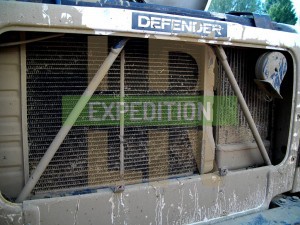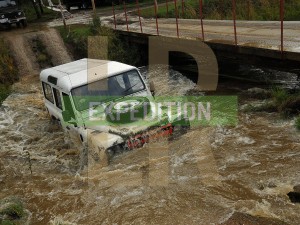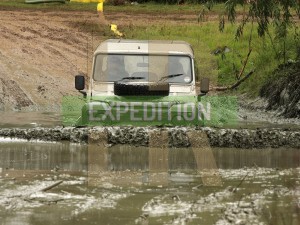Winch and Wade blanket review
With my first Land Rover, I had the unenviable experience of having my radiator burst on the motorway. The week before I had been wading through muddy water at a pay and play site, clogging the radiator fins. I had attempted to clean them out afterwards, but now it was the hottest day of the year at 30 degrees, as I pushed towards 70mph on the motorway. On this bright, blue sky day, the windscreen started accumulating water drops. Thinking it was spray from a passing car as it washed its windscreen, I turned on the wipers.
Then it happened again. I noticed the water was flicking up over the bonnet. Crap. My Dad and I were driving in convoy with my new Land Rover and I could feel the embarassment welling up from within. I pulled over and water was spraying out the front of the grille. A tow from the AA back home resulted in fitting a new radiator to get it roadworthy again. All of this could have been averted by not clogging the fins with mud.
At a Pay and Play site, choosing whether to drive into deep muddy water is a risk you have to calculate. I chose to drive it. On expedition, you may not have the luxury of choice. When push comes to shove, you may have to risk getting your raditator clogged were it not for the simple modification of a wading blanket.
The theory
 The uses of covering over the radiator are deemed to be fourfold:
The uses of covering over the radiator are deemed to be fourfold:
- Stopping the radiator getting clogged with debris/mud
- Limiting water entering the engine compartment that may be sprayed on electrics by the fan
- Creating a less permeable front end that will better create a bow wave
- Preventing air flow in cold weather to keep the engine (and heater) warm
On visiting another pay and play site in my current Land Rover, the radiator got clogged again. I cursed myself and had a nervous drive home watching the temperature gauge.
Getting a wading blanket then crossed my mind quite seriously. Whilst most water encountered on pay and play sites is always muddy, generally stagnant and churned by constant use, deep water encountered on expedition around the world isn't usually muddy. That being said, the benefits above of having a blanket when wading in clean water are also evident.
The tradeoff for using a wading blanket in hot climates is that the engine can't cool itself as well. Using one in these environments will be best for keeping your radiator in the best condition possible, but has to be balanced with the cooling restriction by selecting the appropriateness of the situation. Therefore, you need a simple system that can be deployed and retracted quickly.
The options
 There are several products available to fulfil the same purpose, such as a radiator muff, or even the cheap and cheerful piece of rubber matting or cardboard with bungee cords would suffice.
There are several products available to fulfil the same purpose, such as a radiator muff, or even the cheap and cheerful piece of rubber matting or cardboard with bungee cords would suffice.
I chose the Winch and Wade blanket previously made by the Rugged Guide 4x4 (I believe it is no longer available). It's made from some tough vinyl material and you can have it in any colour as long as it's orange. It's got velcro strips that you can attach and remove it quickly. It'll also roll up out of the way easily. You will have to actually jump out of the cab to do it, but that's what passengers are for! Coupled with this are other uses that the video on their website explains, most notably as a winch sail.
The top piece screws into the slam panel under the bonnet with four screws. It's easy to set up in 5 minutes. The tabs on mine didn't line up that well and skewed, but it's a minor point. From here you can leave this attached and adhere the blanket as you deem fit, rolling up and down as necessary. Rugged Guide advise putting some bungees diagonally across to hold it to the grille if you don't have a winch holding it there, but I found the suck of the viscous fan held it fine.
The verdict
I took it through its paces on the Billing show off road course and it performed very well. At the end, no mud had found its way into the radiator and the fins were clean. You can see below the sort of situation it was up against.
It is a bit pricey around the £40 mark for some plastic and velcro, but you have to weigh it up with what the consequences may be for the type of driving you do. It is also unique in the market. The large amount of the velcro helps, as some of it tends to get clogged with mud, so it still sticks after a dunking.
In all, I would recommend this product as a good bit of kit. It's well made and appropriately cures the problem it sets out to solve. I'm sure its multi-use function will prove its worth in the back of beyond. Thumbs up!








